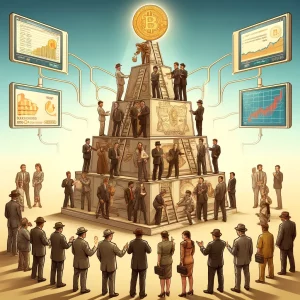Bitcoin Facts: Fun & Interesting Bitcoin Facts 2/2
7 min readTable of Contents
Here’s a collection of Bitcoin facts which may surprise, amuse, or even shock you… Hopefully, you’ll pick up some obscure facts which provide deeper insight into the fascinating world of Bitcoin.

Bitcoin facts part two
There are around 74 forks of Bitcoin
At least 105 altcoins have forked off from Bitcoin and 31 died. The most well-known are Bitcoin Cash (BCH) and Bitcoin Gold (BTG). Like the ICO craze, the forkcoin craze has largely died down, as new forks achieved diminishing returns.
There was even a Bitcoin fork coin generator, known as Forkgen, which allows anyone to create their own fork in a largely automated fashion.
Bitcoin mining consumes about as much energy as a mid-size country
Bitcoin’s current energy usage is estimated at 73 Terawatt-hours (TWh). This is a little more than the consumption of the nation of Chile, which has a population of about 18 million.
It should be kept in mind that Bitcoin mining is only economical if it uses cheap power as an input. Such power tends to be renewable, such as hydro and geothermal. Assuming Bitcoin scales via additional layers, such as the Lightning Network which doesn’t impose additional energy costs, Bitcoin may eventually become a more efficient use of resources than the traditional monetary system.
Green-power cryptocurrency mining is the future
The economist Milton Friedman predicted Bitcoin
Renowned American economist and Nobel Laureate, Milton Friedman, predicted a system very much like Bitcoin in 1999. In this recorded statement, Friedman lays out his vision for a future, internet-based “e-cash” beyond the control of the state.
The politics of Bitcoiners is probably somewhat right-leaning
According to a study conducted by a crypto news site, the majority of the 1,200 cryptocurrency users polled identify as liberal. However, different coin communities have different attitudes.
55% of Bitcoiners identified as right of the political center, which is not surprising given that libertarians and crypto-anarchists were early adopters of Bitcoin. There is also a clearly established trend within Bitcoin against centralized “big government” solutions. The stats were reversed for Ethereum users, who reportedly display a 55% leftwards skew.
The first recorded Bitcoin transaction was a pizza purchase
Back in 2010, 100,000 bitcoins were traded for two Papa John’s pizzas, worth about $25. A coder named Laszlo Hanyecz in America arranged the trade with a British user, “jercos,” in the BitcoinTalk forum. The Brit arranged a transatlantic payment to the pizzeria, which delivered the pizza to Laszlo. This early trade is commemorated on the date it took place, the 22nd of May, by Bitcoiners around the world.
Although the blockchain is constantly growing, optimizations have improved Bitcoin Core’s initial sync time
The Initial Blockchain Download (IBD) is the time it takes for a newly-installed full wallet to download and check the complete blockchain. It’s rather amazing that Bitcoin Core’s IBD has become faster with new versions of the software, despite the blockchain growing by hundreds of megabytes per day. The speed improvement is a result of numerous optimizations which the developers have added over the years.
A Bitcoin (BTC) developer saved Bitcoin Cash (BCH) from a chain split
Cory Fields has been involved in Bitcoin Core development since 2013. In April of 2018, he privately altered the Bitcoin Cash developers to a potentially fatal flaw in their code. If exploited, the bug could have led to the BCH network splitting. When offered a $100,000 bug bounty reward, Fields requested that it be donated to charity.
Bitcoin’s Lightning Network can handle millions of transactions per second
Transaction throughput, often expressed as transactions per second or TPS, sets something of an upper limit on the adoption of a cryptocurrency. Whereas credit card systems like VISA can process around 45,000 TPS, Bitcoin’s blockchain design limits it to double digit TPS. While some altcoins achieve significantly higher TPS, this invariably comes at the cost of decentralization.
Bitcoin solves this issue through the Lightning Network; an optional transaction layer on top of the blockchain. LN retains the full security and decentralized properties of the blockchain, while expanding TPS into the millions.
Some Venezuelans Survived Economic Collapse by Mining Bitcoin
Venezuela’s seizure of private property has led to economic failure in 2018, resource scarcity, and monetary hyperinflation. And Venezuelans mined Bitcoin with their cheap, subsidized power. These subsidies made electricity prices in the country the cheapest in the world. People with access to mining equipment used it to earn enough to survive.
The government did not look kindly on the practice however, andattempted to end it. However, there are credible reports that government officials used expropriated ASIC miners to enrich themselves through mining Bitcoin.
Former Bitcoin Core developer, Mike Hearn, “ragequit” in 2016 while damning Bitcoin as “a failed experiment”
Mike Hearn grew despondent regarding Bitcoin’s development. Mike had long disagreed with other developers over Bitcoin’s proposed scaling path. In January of 2014, Mike wrote a lengthy, pessimistic article, in which he announced his decision to quit. BitTorrent creator, Bram Cohen, famously described Mike’s decision as a “whiny ragequit.”
Satoshi Nakomoto did not foresee mining pools or ASIC hardware
When Satoshi designed Bitcoin, ASIC miners didn’t exist. He envisioned that Bitcoin would be mined on user’s CPUs. However, GPUs were soon discovered to be far more efficient and specialized FPGAs (Field Programmable Gate Arrays) and eventually ASICs (Application Specific Integrated Circuit) were soon developed. Fortunately, Satoshi’s Difficulty mechanism kept the system in balance.
Another thing which Satoshi didn’t expect was the emergence of mining pools. Instead of users mining individually, as per Satoshi’s “one CPU, one vote” design methodology, pools allow users to combine their hashrate. Greater combined hashrate increases the odds of solving blocks more frequently, with the rewards shared among pool members in proportion to their hashrate.
Candidate for Satoshi 1: Hal Finney
Hal Finney, one of the original cypherpunks, was the first person besides Satoshi to run a Bitcoin wallet, mine, and receive bitcoins over the network. Sadly, Hal passed away in 2014. He was involved in improving Bitcoin’s code to the end. His final address to the Bitcoin community is well worth a read.
People speculate that Hal may have been Satoshi due to his early involvement, as well as his coding and cryptographic skills.
Candidate for Satoshi 2: Nick Szabo
Another early cypherpunk, Nick Szabo created a decentralized monetary system in 1998 known as Bit Gold. This system is considered a precursor to Bitcoin. Nick developed the concept of smart contracts, which are used by Bitcoin and other cryptos. He is knowledgeable across multiple fields, including computer science, cryptography, and law.
People speculate that Szabo is Satoshi due to his Bit Gold project and interest in smart contracts.
Candidate for Satoshi 3: Wei Dai
Wei Dai was another cypherpunk, who created an alternative monetary system known as b-money, which was similar in concept to Bitcoin. Wei Dai is a computer engineer who conducted cryptographic research for Microsoft and made several advancements in the field.
People speculate that Wei Dai could be Satoshi, due to his b-money project and cryptographic skills, as well as his private nature.
Candidate for Satoshi 4: Adam Back
Another strong possibility for Satoshi Nakomoto is the cryptographer and cypherpunk, Adam Back. Adam currently runs the Bitcoin-based software company, Blockstream (mentioned in point 32). He was attributed in Satoshi’s white paper, as the inventor of the Hashcash system upon which Bitcoin’s Proof of Work mining is based.
People speculate that Adam Back may be Satoshi due to his leading role in Blockstream and invention of Hashcash.
Other candidates for Satoshi include Ian Grigg, Tim May, and many more…
It’s possible that Satoshi Nakomoto was a Group
Another tantalizing possibility is that some or all of the above-mentioned individuals collaborated to create Bitcoin under the pseudonym of Satoshi Nakomoto. Stylometric analysis has been used to compare the writing style of each person to the known writings of Satoshi, including the Bitcoin white paper, various emails, and forum posts. An interesting degree of similarity has been found…
Bitcoin private keys are integers between 1 and 1077
If you were able to make a trillion guesses per second, you’d have to guess for about 3.3 decillion (1033) years to find the private key to a particular Bitcoin address. Of course it’s always possible that scientific advances, such as quantum computing, could make it feasible to crack a Bitcoin address. In this case, Bitcoin would have to hard fork to quantum-resistant cryptography.






